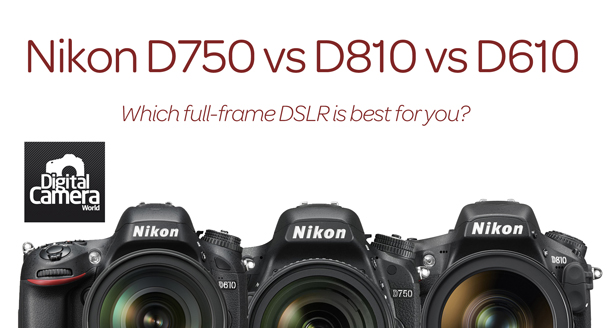Nikon D750 vs D810 vs D610: 10 key differences you need to know

Nikon now has several full-frame DSLRs on the market - but which is the best one for you? We take a look at the key specs and differences between these three cameras in our Nikon D750 vs Nikon D810 vs Nikon D610 comparison.

Nikon's new D750 DSLR (see our Nikon D750 review) was announced in September 2014 at Photokina and sits in between the D610 (see our Nikon D610 review), Nikon's "entry level" full-frame DSLR and the D810 (see our Nikon D810 review).
It features many of the same specifications as the Nikon D810, but also a number of key differences that make it more appealing in some ways than its more expensive sibling. But, if you're on a budget, it could be that the Nikon D610 is actually the most tempting prospect.
All of them are fantastic cameras, but let's take a look at the key specifications to help differentiate between the models.
SEE MORE: Full-frame sensor size explained: how to exploit its advantages and cool effects
Nikon D750 vs Nikon D810 vs Nikon D610: 01 sensor

The Nikon D800 made headlines when it was announced thanks to its huge pixel count, and the D810's 36 million pixels is still the highest resolution full-frame DSLR sensor currently on the market.
If you're working in advertising or commercial photography and need the ability to print at huge sizes, this incredible pixel count is really appealing - it's also useful for cropping into images for better composition.
Sign up for breaking news, reviews, opinion, top tech deals, and more.
Meanwhile, both the D750 and the D610 have a more than adequate for most scenarios 24.3 million pixels - Nikon says that the D750's sensor is newly designed, though.
Another consideration is that the D810 has no anti-aliasing filter over the sensor, while the Nikon D750 and D610 do - which makes the Nikon D810 better for resolving ultra fine detail.
Architectural and landscape photographers may find this particularly useful.
SEE MORE: Canon EOS 7D Mark II vs EOS-1D X vs Nikon D4s vs Samsung NX1
Nikon D750 vs Nikon D810 vs Nikon D610: 02 autofocus

Both the Nikon D810 and the D750 feature a Multi-CAM 3500 FX sensor, which features 51 autofocus points, of which 15 are ultra-sensitive cross type.
The Nikon D750 also has Group Area AF for improved accuracy, while the D610 by comparison has a Multi-CAM 4800 sensor, with only 39 autofocus points, of which 9 are cross type.
Although the D610 seems like the worse choice here, it's worth remembering that plenty of other full-frame DSLRs, such as the Canon 6D, have far fewer autofocus points.
SEE MORE: Nikon D810 vs Canon EOS 5D Mark III - full-frame DSLRs go head-to-head
Nikon D750 vs Nikon D810 vs Nikon D610: 03 sensitivity range
The Nikon D810 fares best with its sensitive range, reaching all the way down to a very low 64, right up to 12,800 in its native range.
You can also expand these settings down to ISO 32 and up to 51200 should you need it.
The lower sensitivity setting is useful when you want the ultimate image quality for landscapes and so on.
Both the Nikon D750 and the D610 have lowest sensitivity settings of ISO 100, expandable down to 50.
Meanwhile, the upper limit of the Nikon D750 is also 12800 in its native setting (expandable to 51200), but the Nikon D610 only manages ISO 6400 (expandable to 25600) at the top end.
SEE MORE: Nikon D4s vs D4: 14 things you need to know about Nikon's flagship DSLR
Nikon D750 vs Nikon D810 vs Nikon D610: 04 screen and viewfinder

All three of the cameras have a pentaprism optical viewfinder which offers 100% coverage and 0.7x magnification, but the screens have differences - especially so with the D750.
Both the Nikon D810 and the D610 have fixed 3.2 inch screens, but the D810's is a higher resolution at 1229k dot, compared with the D610's 921k dot.
The Nikon D750 trumps both offering the company's first tilting screen for a full-frame DSLR - although it's perhaps not as useful as a touch sensitive screen, it's still handy for composing from awkward angles, and it's got the same high resolution as the D810.
SEE MORE: 100 Nikon DSLR tips you really need to know
Nikon D750 vs Nikon D810 vs Nikon D610: 05 build and weight
All of the cameras boast some level of sturdiness and rugged capabilities.
The new Nikon D750 has a monocoque construction (which basically means its made from one single piece of material rather than made up of parts attached to each other).
It is made from sturdy carbon fibre and magnesium alloy and is sealed from dust and moisture. It has been tested to 150,000 cycles too, so it should last a fair old while.
The Nikon D610 has also been tested to 150,000 cycles, and is also dust and weather resistant.
However if you're worried about the camera lasting a long time, the D810 offers the best testing at 200,000 cycles, perhaps making it more appealing to professional photographers who will be taking photos every day.
If however you're looking for something smaller and lighter, the Nikon D750 is your best bet, weighing in at 840g, making it around 140g lighter than the Nikon D810 - it may not sound like a huge amount, but it can make a difference when you're carrying (and lifting) something around all day.
The Nikon D750 is also the smallest at 140.5 x 113 x 78mm, but the D610 is only fractionally larger and heavier than the D750.
READ MORE
Canon vs Nikon: the in-depth DSLR comparison you've been waiting for!
49 seriously good Canon DSLR tips, tricks, shortcuts and time-savers
99 common photography problems (and how to solve them)
77 photography techniques, tips and tricks for taking pictures of anything